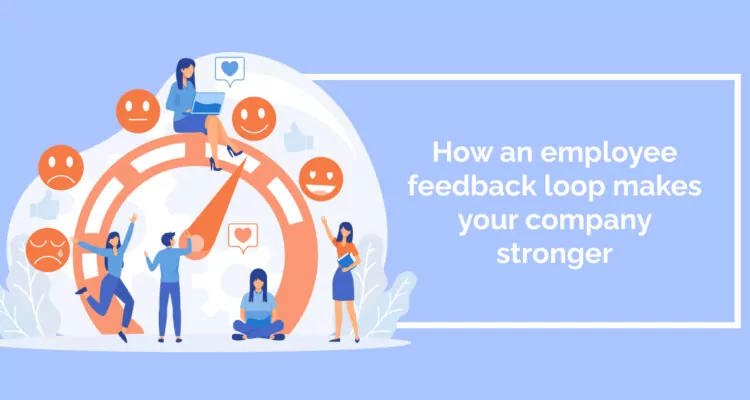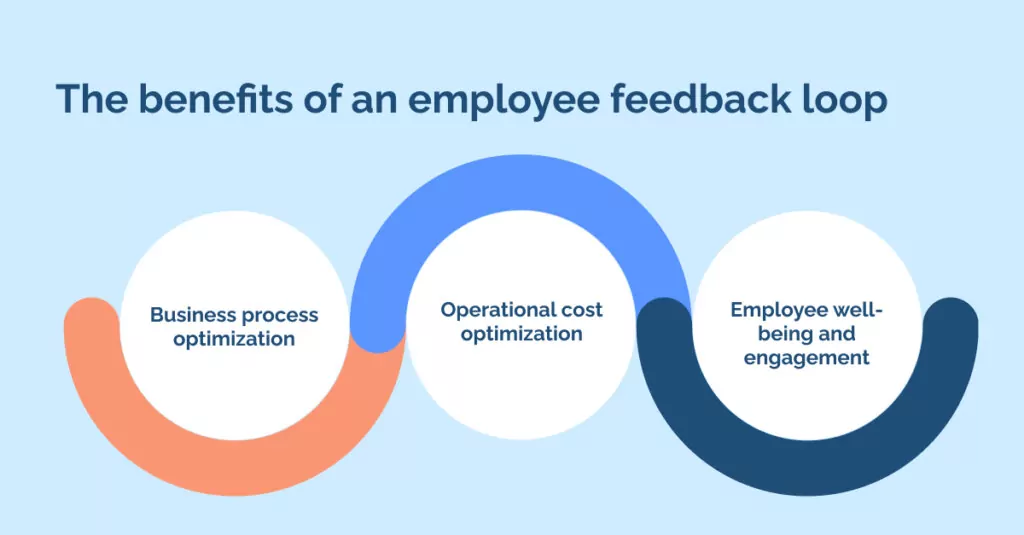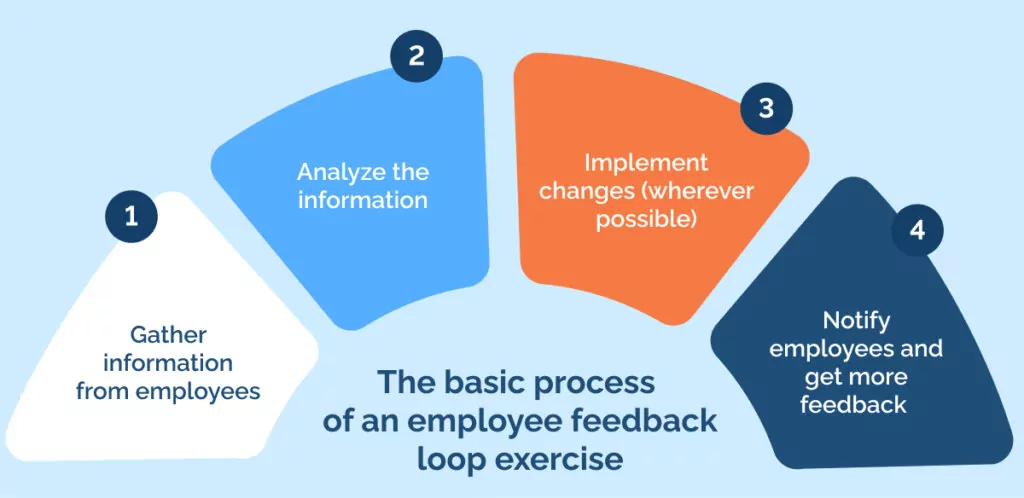
Employees are one of the most undervalued sources of company feedback. Rank-and-file staff don’t always have it right. But they have insights into your operations that you couldn’t get from an expensive consultant, a maverick leader, or the latest research.
When you use those employee insights to make changes in your business, you’ve got the starting point for an employee feedback loop. Basing the future off employees’ knowledge and experience is a great way to enhance employee engagement, reduce resistance to change, and make your company work better.
This article will help you understand how to use employee feedback loops effectively in your organization. It will:
- Define the employee feedback loop and its distinctions between positive and negative feedback loops
- Introduce the top benefits of an employee feedback loop
- Show the four steps in the basic employee feedback loop process
- Examine some best practices for creating effective feedback loops.
Employee feedback loops have a lot of potential for business growth in an increasingly competitive marketplace.
2021 research from Gartner shows how equitable and two-way feedback is now the go-to strategy for HR leaders. Strong employee feedback loops are another tool for building a culture of trust and respect that makes a long-term difference.
What is an employee feedback loop?
An employee feedback loop is a way of gathering information and changing any aspect of a business.
In a feedback loop, employees can receive feedback about their performance, make changes, and then receive further feedback on their updated performance. Alternatively, employees may give feedback to leaders about aspects of the business that they act upon and communicate the outcomes to the employees.
Employee feedback loops create a continuous and open channel of communication that fosters improvement, engagement, and development for both the individual employees and the organization as a whole.
Regular performance reviews can create feedback loops: 360-degree feedback, an open-door policy, and recognition and rewards programs. However, a good employee loop requires a very strong organizational culture in which everyone has the confidence to give feedback and expect results.
Employee feedback loops are just one of the feedback loops a business can use. Large organizations will also use customer feedback loops, client feedback loops, and vendor feedback loops.
Positive and negative feedback loop definitions
While some writers may interchange the term “positive feedback loop” with “employee feedback loop,” caution is warranted. These terms carry diverse meanings across various contexts, including biology, engineering, and social media.
Even within the realm of business writing, there exists variability in their usage. In this section, we will clarify these meanings.
Positive feedback loop definition
- First Definition: A positive feedback loop occurs when a company actively considers all feedback from staff —complaints, problems, and suggestions—offering a comprehensive view of the organizational landscape. This aligns closely with the “employee feedback loop” concept discussed in this article.
- Alternative: A positive feedback loop can occur when an organization encourages feedback to fortify existing strengths. This approach, like appreciative inquiry, contributes to the organization’s robust and positive development.
Negative feedback loop definition
- First Definition: A negative feedback loop happens when companies look to their consumers and customers for improvements. They will analyze input from social media or surveys to drive changes in their products and services.
- Alternative: It can also refer to the examination of criticisms, whether internal or external, leading to corrective actions. This approach will improve any aspect of a business’s offering. However, it may feel reactive and disheartening in some situations.
All of these definitions are valuable in different contexts. You must be clear about what you mean. Researchers in employee feedback suggest alternative descriptors, such as distinguishing between “self-reinforcing and self-correcting” or “reinforcing and balancing.”
These nuanced distinctions help refine the understanding of feedback dynamics within organizational contexts.
What are the benefits of an employee feedback loop?

An employee feedback loop helps enhance the quality of business processes, optimize operational costs, and promote overall employee well-being. It also aligns organizational goals with employee experiences, creating a symbiotic relationship that benefits the business and its workforce.
Business process optimization
Implementing an employee feedback loop helps leaders identify and address their operations’ pain points, bugs, and features. By soliciting employee feedback, organizations gain valuable insights into areas requiring improvement or innovation. This iterative process contributes to refining and streamlining workflows, ultimately fostering efficiency and effectiveness.
Operational cost optimization
A well-structured feedback loop allows organizations to optimize operations, potentially saving costs. Businesses can implement targeted improvements that reduce inefficiencies by understanding the challenges employees face in their day-to-day tasks. This optimization enhances the organization’s overall performance and can contribute to increased return on investment (ROI) and improved profit margins.
Employee well-being and engagement
Beyond the tangible improvements in processes and costs, the employee feedback loop fosters employee engagement and well-being. Engaged employees are more likely to be satisfied with their work, leading to increased motivation, productivity, and overall job satisfaction. The loop creates a culture of open communication, making employees feel heard and valued.
The basic process of an employee feedback loop exercise

Once you have defined your objectives, the steps of an employee feedback loop usually follow this basic pattern.
Gather information from employees
The employee feedback loop process begins with gathering valuable information from your workforce. This step is crucial for understanding employees’ perspectives, experiences, and opinions. Feedback can be collected through various methods, including surveys, performance appraisals, or software usage such as Digital Adoption Platforms (DAP), Learning Management Systems (LMS), and other relevant tools.
Analyze the information
The next step involves a thorough analysis of the collected information in hand. This can be done using a variety of approaches, including qualitative and quantitative methods, data analytics, and even sentiment analysis for a more nuanced understanding.
A feedback loop gathers information to inform action. At this stage, the goal is to distill the gathered data into clear and actionable insights.
Implement changes (wherever possible)
Following the analysis, the identified insights and recommendations are considered for implementation. It’s important to recognize that not all feedback may be actionable; in some cases, changes may not be feasible. However, organizations should proactively implement changes where feasible to address concerns, improve processes, and enhance the overall employee experience.
Notify employees and get more feedback
Communication is key in the feedback loop process. Once changes have been implemented, it’s crucial to notify employees about the actions taken based on their feedback. This communication can take various forms, including emails, bulletins, or staff meetings. Additionally, organizations should encourage ongoing feedback, creating a continuous loop where employees feel empowered to share their thoughts, leading to further improvements.
Best practices for implementing an employee feedback loop
Implementing an effective employee feedback loop involves strategic tactics and cultural practices to ensure meaningful insights and continuous improvement.
Here are best practices to enhance the effectiveness of your feedback loop:
- Timely feedback requests. Solicit feedback promptly after implementing changes or initiatives, ensuring relevance and maximizing the potential for actionable insights.
- Act on the findings. Make tangible implementations of suggested actions and communicate these changes clearly to employees. Transparency in execution builds trust.
- Utilize Digital Solutions: Use digital tools and platforms for efficient and accessible employee surveys. Digital solutions streamline the feedback collection process and provide valuable data analytics capabilities.
- Make sure you have an honest conversation. Empower employees to lead conversations that foster honesty. Creating an environment where open and candid discussions are encouraged allows for more authentic feedback.
- Diverse perspectives. Ensure feedback is collected from employees with diverse backgrounds and across various business units. This diversity ensures a comprehensive understanding of how different parts of the company experience work.
- Trust Building. Facilitate understanding of what trust looks like in the context of employee relationships. Encourage reflection on the level of trust within the organization. Trust is foundational for honest feedback, a key element in an effective feedback loop.
Implementing these best practices fosters a culture of transparency, engagement, and continuous improvement within the organization, ultimately strengthening the impact of your employee feedback loop.
Feedback loops for effective change
Too often, “feedback” is just an exercise to keep employees quiet. If people have their say (the logic goes), they will quiet down and stay compliant.
If this resonates with your business, it’s time to elevate your approach to feedback loops. The value of an employee feedback loop lies in its tangible impact on refining your business’s operational practices.
However, it is imperative to recognize that your employees are discerning individuals. Their motivation may decrease if they do not observe the requisite changes from their feedback.
Too many companies forget it. 2023 research from Gartner makes it clear: “Only one-third of employees believe their organization will act on their feedback, while 46% of employees wish their organization did more to address employee feedback.”
To create a trusting environment, it’s time to make your employee feedback the starting point for action. It might not be easy, but the impact in the long run will speak for itself.
WalkMe Team
WalkMe spearheaded the Digital Adoption Platform (DAP) for associations to use the maximum capacity of their advanced resources. Utilizing man-made consciousness, AI, and context-oriented direction, WalkMe adds a powerful UI layer to raise the computerized proficiency, everything being equal.



